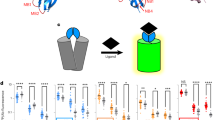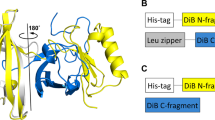Abstract
Imaging of live cells has been revolutionized by genetically encoded fluorescent probes, most famously green and other fluorescent proteins, but also peptide tags that bind exogenous fluorophores1. We report here the development of protein reporters that generate fluorescence from otherwise dark molecules (fluorogens). Eight unique fluorogen activating proteins (FAPs) have been isolated by screening a library of human single-chain antibodies (scFvs) using derivatives of thiazole orange and malachite green. When displayed on yeast or mammalian cell surfaces, these FAPs bind fluorogens with nanomolar affinity, increasing green or red fluorescence thousands-fold to brightness levels typical of fluorescent proteins. Spectral variation can be generated by combining different FAPs and fluorogen derivatives. Visualization of FAPs on the cell surface or within the secretory apparatus of mammalian cells can be achieved by choosing membrane permeant or impermeant fluorogens. The FAP technique is extensible to a wide variety of nonfluorescent dyes.
This is a preview of subscription content, access via your institution
Access options
Subscribe to this journal
Receive 12 print issues and online access
$209.00 per year
only $17.42 per issue
Buy this article
- Purchase on Springer Link
- Instant access to full article PDF
Prices may be subject to local taxes which are calculated during checkout



Similar content being viewed by others
Accession codes
Change history
19 March 2008
In the version of this article initially published online, an author’s middle initial was incorrectly given as “A” Brigitte A Schmidt should be Brigitte F Schmidt in the author list, and B.A.S should be B.F.S. in the authors’ contribution section. The error has been corrected in the HTML and PDF versions of the article.
References
Giepmans, B.N., Adams, S.R., Ellisman, M.H. & Tsien, R.Y. The fluorescent toolbox for assessing protein location and function. Science 312, 217–224 (2006).
Yao, J., Munson, K.M., Webb, W.W. & Lis, J.T. Dynamics of heat shock factor association with native gene loci in living cells. Nature 442, 1050–1053 (2006).
Miesenbock, G., De Angelis, D.A. & Rothman, J.E. Visualizing secretion and synaptic transmission with pH-sensitive green fluorescent proteins. Nature 394, 192–195 (1998).
Pertz, O., Hodgson, L., Klemke, R.L. & Hahn, K.M. Spatiotemporal dynamics of RhoA activity in migrating cells. Nature 440, 1069–1072 (2006).
Marks, K.M. & Nolan, G.P. Chemical labeling strategies for cell biology. Nat. Methods 3, 591–596 (2006).
Adams, S.R. et al. New biarsenical ligands and tetracysteine motifs for protein labeling in vitro and in vivo: synthesis and biological applications. J. Am. Chem. Soc. 124, 6063–6076 (2002).
Martin, B.R., Giepmans, B.N., Adams, S.R. & Tsien, R.Y. Mammalian cell-based optimization of the biarsenical-binding tetracysteine motif for improved fluorescence and affinity. Nat. Biotechnol. 23, 1308–1314 (2005).
Rozinov, M.N. & Nolan, G.P. Evolution of peptides that modulate the spectral qualities of bound, small-molecule fluorophores. Chem. Biol. 5, 713–728 (1998).
Farinas, J. & Verkman, A.S. Receptor-mediated targeting of fluorescent probes in living cells. J. Biol. Chem. 274, 7603–7606 (1999).
Hauser, C.T. & Tsien, R.Y. A hexahistidine-Zn2+-dye label reveals STIM1 surface exposure. Proc. Natl. Acad. Sci. USA 104, 3693–3697 (2007).
Keppler, A. et al. A general method for the covalent labeling of fusion proteins with small molecules in vivo. Nat. Biotechnol. 21, 86–89 (2003).
Chen, I., Howarth, M., Lin, W. & Ting, A.Y. Site-specific labeling of cell surface proteins with biophysical probes using biotin ligase. Nat. Methods 2, 99–104 (2005).
Reck-Peterson, S.L. et al. Single-molecule analysis of dynein processivity and stepping behavior. Cell 126, 335–348 (2006).
Feldhaus, M.J. et al. Flow-cytometric isolation of human antibodies from a nonimmune Saccharomyces cerevisiae surface display library. Nat. Biotechnol. 21, 163–170 (2003).
Nygren, J., Svanvik, N. & Kubista, M. The interactions between the fluorescent dye thiazole orange and DNA. Biopolymers 46, 39–51 (1998).
Babendure, J.R., Adams, S.R. & Tsien, R.Y. Aptamers switch on fluorescence of triphenylmethane dyes. J. Am. Chem. Soc. 125, 14716–14717 (2003).
Iwaki, T., Torigoe, C., Noji, M. & Nakanishi, M. Antibodies for fluorescent molecular rotors. Biochemistry 32, 7589–7592 (1993).
Siegel, R.W., Coleman, J.R., Miller, K.D. & Feldhaus, M.J. High efficiency recovery and epitope-specific sorting of an scFv yeast display library. J. Immunol. Methods 286, 141–153 (2004).
Giudicelli, V. et al. IMGT/LIGM-DB, the IMGT comprehensive database of immunoglobulin and T cell receptor nucleotide sequences. Nucleic Acids Res. 34, D781–D784 (2006).
Colby, D.W. et al. Engineering antibody affinity by yeast surface display. Methods Enzymol. 388, 348–358 (2004).
Patterson, G.H., Knobel, S.M., Sharif, W.D., Kain, S.R. & Piston, D.W. Use of the green fluorescent protein and its mutants in quantitative fluorescence microscopy. Biophys. J. 73, 2782–2790 (1997).
Simeonov, A. et al. Blue-fluorescent antibodies. Science 290, 307–313 (2000).
Shaner, N.C. et al. Improved monomeric red, orange and yellow fluorescent proteins derived from Discosoma sp. red fluorescent protein. Nat. Biotechnol. 22, 1567–1572 (2004).
Huang, D. & Shusta, E.V. Secretion and surface display of green fluorescent protein using the yeast Saccharomyces cerevisiae. Biotechnol. Prog. 21, 349–357 (2005).
Baptista, M.S. & Indig, G.L. Effect of BSA binding on photophysical and photochemical properties of triarylmethane dyes. J. Phys. Chem. B 102, 4678–4688 (1998).
Surrey, T. et al. Chromophore-assisted light inactivation and self-organization of microtubules and motors. Proc. Natl. Acad. Sci. USA 95, 4293–4298 (1998).
Remington, S.J. Fluorescent proteins: maturation, photochemistry and photophysics. Curr. Opin. Struct. Biol. 16, 714–721 (2006).
Colby, D.W. et al. Development of a human light chain variable domain (V(L)) intracellular antibody specific for the amino terminus of huntingtin via yeast surface display. J. Mol. Biol. 342, 901–912 (2004).
Tanaka, T., Lobato, M.N. & Rabbitts, T.H. Single domain intracellular antibodies: a minimal fragment for direct in vivo selection of antigen-specific intrabodies. J. Mol. Biol. 331, 1109–1120 (2003).
Proba, K., Worn, A., Honegger, A. & Pluckthun, A. Antibody scFv fragments without disulfide bonds made by molecular evolution. J. Mol. Biol. 275, 245–253 (1998).
Motulsky, H. & Christopoulos, A. . Fitting Models to Biological Data Using Linear and Nonlinear Regression: A Practical Guide to Curve Fitting. (Oxford University Press, Oxford; New York, 2004).
Kubin, R.F. & Fletcher, A.N. Fluorescence quantum yields of some rhodamine dyes. J. Lumin. 27, 455–462 (1982).
Lacowicz, J. Principles of Fluorescence Spectroscopy edn 2. (Kluwer Academic/Plenum, London, 1999).
Mujumdar, R.B., Ernst, L.A., Mujumdar, S.R., Lewis, C.J. & Waggoner, A.S. Cyanine dye labeling reagents: sulfoindocyanine succinimidyl esters. Bioconjug. Chem. 4, 105–111 (1993).
Sims, P.J., Waggoner, A.S., Wang, C.H. & Hoffman, J.F. Studies on the mechanism by which cyanine dyes measure membrane potential in red blood cells and phosphatidylcholine vesicles. Biochemistry 13, 3315–3330 (1974).
Mueller, W.H.I., Schuetz, H.J. & Meyer, G. Polyethylene glycol derivatives of base and sequence specific DNA ligands: DNA interaction and application for base specific separation of DNA fragments by gel electrophoresis. Nucleic Acids Res. 95, 95–119 (1981).
Acknowledgements
We thank Dane Wittrup for providing an aliquot of the yeast scFv surface display library, members of his laboratory for advice and Nicholas Bateman for work on scFv maturation. Supported by National Institutes of Health grant 7 U54 RR022241 and Pennsylvania Department of Health grant 4100020575.
Author information
Authors and Affiliations
Contributions
B.F.S. synthesized fluorogens and derivatives; C.S.-G. and Y.C. cloned fluorogenic scFvs under the direction of C.S.-G.; K.L.Z. carried out cloning-related molecular biology and protein purification; under the direction of J.W.J., S.A. constructed mammalian expression vectors with contribution from K.V.V.; G.W.F. and Q.Y. created stable mammalian cell lines; G.W.F. and J.A.J.F. performed microscopy; C.A.W. implemented directed evolution mutagenesis with contribution from P.B.B.; C.S.-G. conducted spectroscopy and binding experiments and analysis; C.S.-G. drafted manuscript and figures; M.P.B., J.W.J., P.B.B. and A.W. contributed editorially to manuscript and to general design of research; A.W. conceived fluorogen strategy and oversaw entire project.
Corresponding authors
Supplementary information
Supplementary Text and Figures
Supplementary Tables 1, Figures 1–8, Methods (PDF 1556 kb)
Rights and permissions
About this article
Cite this article
Szent-Gyorgyi, C., Schmidt, B., Creeger, Y. et al. Fluorogen-activating single-chain antibodies for imaging cell surface proteins. Nat Biotechnol 26, 235–240 (2008). https://doi.org/10.1038/nbt1368
Received:
Accepted:
Published:
Issue Date:
DOI: https://doi.org/10.1038/nbt1368
This article is cited by
-
Design of a palette of SNAP-tag mimics of fluorescent proteins and their use as cell reporters
Cell Discovery (2023)
-
Caveat fluorophore: an insiders’ guide to small-molecule fluorescent labels
Nature Methods (2022)
-
Plasma membrane flipping of Syntaxin-2 regulates its inhibitory action on insulin granule exocytosis
Nature Communications (2022)
-
LAG3 associates with TCR–CD3 complexes and suppresses signaling by driving co-receptor–Lck dissociation
Nature Immunology (2022)
-
Advanced imaging and labelling methods to decipher brain cell organization and function
Nature Reviews Neuroscience (2021)



